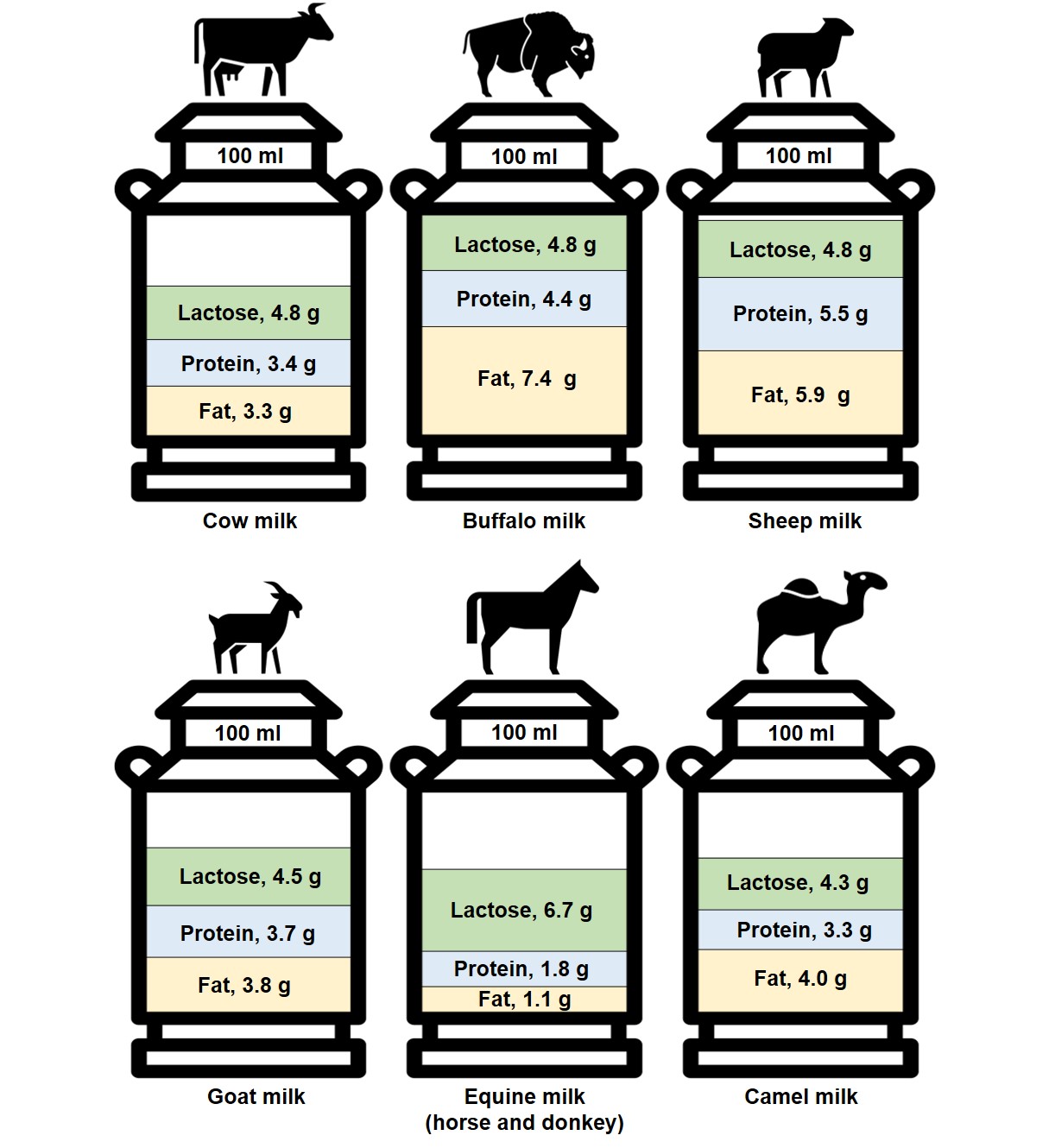1000/1000
Hot
Most Recent

| Version | Summary | Created by | Modification | Content Size | Created at | Operation |
|---|---|---|---|---|---|---|
| 1 | Jack Penhaligan | + 7227 word(s) | 7227 | 2022-01-21 04:31:05 | | | |
| 2 | Jack Penhaligan | -1 word(s) | 7226 | 2022-02-15 05:45:01 | | | | |
| 3 | Jack Penhaligan | -57 word(s) | 7170 | 2022-02-15 07:01:32 | | | | |
| 4 | Jack Penhaligan | -1879 word(s) | 5291 | 2022-02-24 04:56:18 | | | | |
| 5 | Amina Yu | -30 word(s) | 5261 | 2022-02-24 05:15:05 | | |
The whole milk product (and individual milk ingredients) from different species could impact cardiometabolic health.
The consumption of cow dairy products is a dominant feature in the diet of many cultures globally, particularly among Western communities. There is some evidence from epidemiological studies and systematic reviews alike that dairy intake is inversely linked with the risk of developing metabolic syndrome [1][2][3]. More pertinently, a body of data supports a negative association between milk intake and the risk of developing dysglycaemia, dyslipidaemia, and hypertension [1][4]. However, with gold-standard data from long-term randomised controlled trials (RCTs) featuring type II diabetes (T2D) and cardiovascular disease (CVD) incidence as primary endpoints not currently available, the causality of these findings remains to be confirmed [5]. Nonetheless, putative explanations for a possible metabolic syndrome risk reduction include a direct modulation of the glycaemic response [2][6], and an indirect modulation of body weight through upregulation of postprandial thermogenesis [6][7][8] and/or suppression of appetite [9][10][11]. Features of, or responses to, milk that might contribute to any cardiometabolic protection include the bioactive peptide content [12][13]; fatty acid (FA) content [14], e.g., conjugated linoleic acid (CLA) [15]; glycaemic index (GI) [16][17]; promotion of satiety [18]; mineral content, particularly calcium, magnesium, and potassium [19][20][21][22]; and folate bioavailability [23].
Although there is growing data on the acute and chronic health benefits of cow milk, albeit not yet conclusive, whether milk from alternative (non-bovine) sources could provide comparable or superior cardiometabolic protection has not yet been comprehensively reviewed.
The worldwide commercial production of cow milk decisively eclipses the relatively minor contributions from alternative animal species (Table 1). Nonetheless, these milks remain valuable primary sources for many countries and communities globally.
Table 1. Mean contribution of individual species’ milks towards global production. [24]
| Milk Origin | Global Milk Production (%) | Global Milk Production (kg) |
|---|---|---|
| Cow | 81.3 | 714,400,000,000 |
| Buffalo | 14.8 | 130,300,000,000 |
| Goat | 2.2 | 18,900,000,000 |
| Sheep | 1.3 | 11,800,000,000 |
| Camel | 0.4 | 3,200,000,000 |
Values rounded to nearest 0.1 percent or 109 kg.
Owing to the specific make-up of proteins (e.g., β-lactoglobulin; β-lg) and sugars (e.g., lactose) within cow milk, the global prevalence of cow milk allergy and intolerance is notably high. Approximately 65% of adults worldwide have a suboptimal capacity to digest and absorb lactose [25]. In Asian and American Indian populations, the reported prevalence of lactose intolerance is closer to 100% [26][27]. However, with marked compositional differences (see Figure 1), hypoallergenicity and improved tolerability have been indicated following the ingestion of goat [28], sheep [29], camel [30], buffalo [31], and donkey [32] milk, as compared to cow milk. It should be noted that throughout this review buffalo milk refers to the produce of animals of the Bubalus genus.
Lastly, non-dairy substitutes for milk, including soy, oat, rice, and nut ‘milk beverages’ have received growing attention. These plant-based alternatives are formulated through the disintegration of plant material, extraction in water, and subsequent homogenisation, which produces a ‘milk’ reminiscent of the consistency and appearance of animal milk [33]. Despite a typically substandard macronutrient profile relative to mammalian milk, plant-based ‘milks’ possess distinct functional ingredients, lower allergenicity and greater affordability, which have impelled a noticeable surge in demand and production.

Figure 1. The composition of different species’ milk by fat, protein, and lactose content per 100 mL [22][29][34][35]. Equine milk values represent the mean nutrient content in mare and donkey milks.
The effect of milk origin on cardiometabolic health is an emerging area of research. There is some data, although primarily from compositional analyses [35][144], in vitro studies [145], animal studies [146], and acute clinical RCTs [147][148][149], that milk from non-bovine origin (notably sheep and goat milk) could prove to be a viable substitute to cow milk for the maintenance, or even enhancement, of cardiometabolic health. However, a collation of the compositional differences and postulated therapeutic utility, indicate that the level of evidence required to form nutritional recommendations surrounding milk origin is currently lacking. Nonetheless, there are some interesting results, albeit largely from preliminary studies, that have generated excitement around sheep milk consumption for the possible attenuation of cardiometabolic risk. This interest is largely based upon its favourable profile of lipids (for example, MCTs, CLA), protein (for example,, leucine), and minerals (for example, calcium). In theory, these compounds could provide protection from obesity, T2D, and CVD through the modulation of postprandial glycaemia, lipidaemia and aminoacidaemia; nutrient processing; postprandial thermogenesis; and/or appetite. Comparably, with desirable nutritional compositions and some promising early findings, goat and buffalo milk may also prove to be robust alternatives to cow milk. However, as with sheep milk, there is currently a stark absence of high-quality research in humans. Hence, as remains pertinent for cow milk, to substantiate any claims that the consumption of cow-milk alternatives can improve cardiometabolic health, causal data from long-term clinical RCTs, ideally with T2D and/or CVD events as the primary endpoint, are required. Evidence from large-scale studies that support the conjectures formed could not only be of value to individuals allergic or intolerant to cow milk, but potentially also to those at an increased risk of cardiometabolic disease.